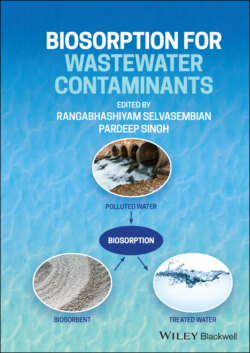Читать книгу Biosorption for Wastewater Contaminants - Группа авторов - Страница 24
Introduction
ОглавлениеWater plays a significant role in the global economy. Water covers most (71%) of the Earth's surface, but water from fresh sources like rivers, lakes, and streams contributes only 3% to total water resources. Freshwater bodies provide water suitable for human consumption. About 70% of freshwater is expended on irrigation. In many countries, these natural resources are limited, and their unavailability poses significant social and economic concerns (Baroni et al., 2007). As the quantity of water decreases, water quality is also seriously declining due to industrial, municipal, and agricultural wastes. Contamination can arise from wastewater leaking from damaged pipes and the flow of industrial waste into water. This contaminated water poses a constant danger to public health in the form of water‐borne diseases (Arshad and Imran, 2020).
Heavy metal exposure is considered a major environmental concern and a hazard to human health among numerous contaminations in drinking water. Even in minute amounts, toxic metals can cause toxicity when they enter the body due to their non‐degradable nature. Mercury, nickel, arsenic, chromium, manganese, copper, zinc, and cadmium are the most widely intoxicating heavy metals (Jaishankar et al., 2014). The wastewater streams from plating, casting, painting dyes, batteries, mining, and farming are key contributors to heavy metals entering the ecosystem (Ibrahim and Mutawie, 2013). Because of their toxic effects, most heavy metals produce various issues, including kidney problems, brain activity difficulties, and nervous weakness. Sleeplessness, impatience, anemic, dizziness, and muscle pain are some of their hazardous symptoms (Fu and Wang, 2011).
Several techniques for the biosorption of toxic metals from effluent have been developed. They include ion exchange, evaporation, chemical precipitation, and membrane filtration. Activated carbon is by far the most common and widely utilized material for treating wastewater pollution. Materials that are used to prepare higher‐quality activated carbon cost more (Babel, 2003). In recent years, awareness has increased of the development of adsorbents to substitute for expensive activated carbon. The emphasis is on adsorbents that can bind to metal and remove undesirable heavy metals from polluted water at a low cost.
Biosorption and bioaccumulation are environmentally friendly solutions with benefits compared to traditional methods. Owing to their metal‐binding functional groups, abundant natural materials have been considered as viable biosorbents for eliminating heavy metals: for example, microbial biomass, agro waste, and industrial byproducts. Parameters such as pH, temperature, metal ion concentration, biosorbent dose, and agitation rate influence biosorption. After the removal of heavy metals, biosorbents can be regenerated and reused, thus making the process economical (Kanamarlapudi et al., 2018). This chapter provides a summary of some low‐cost biosorbents discussed in recent publications.
